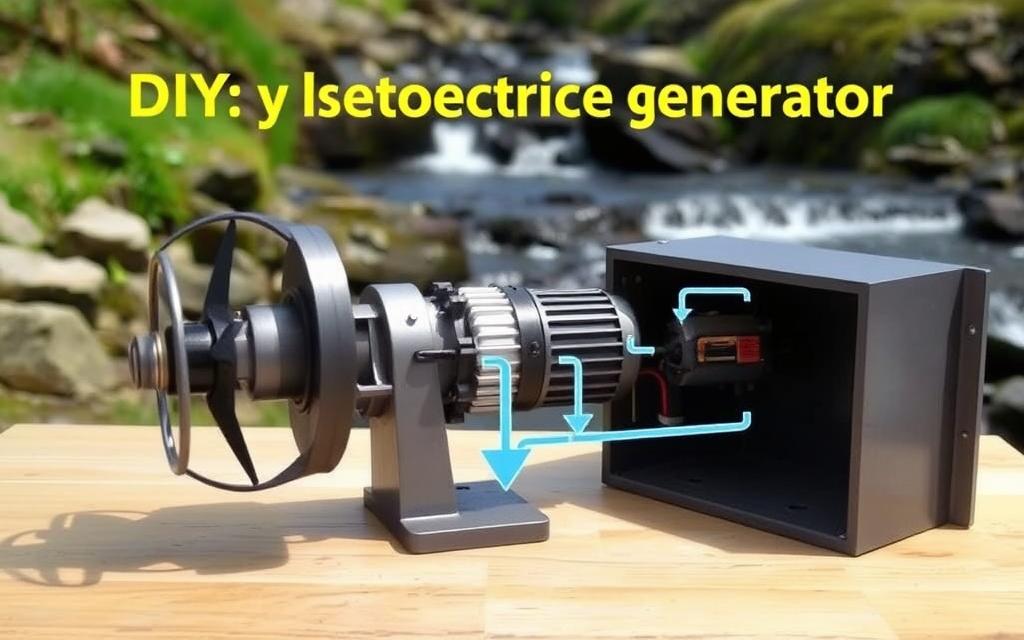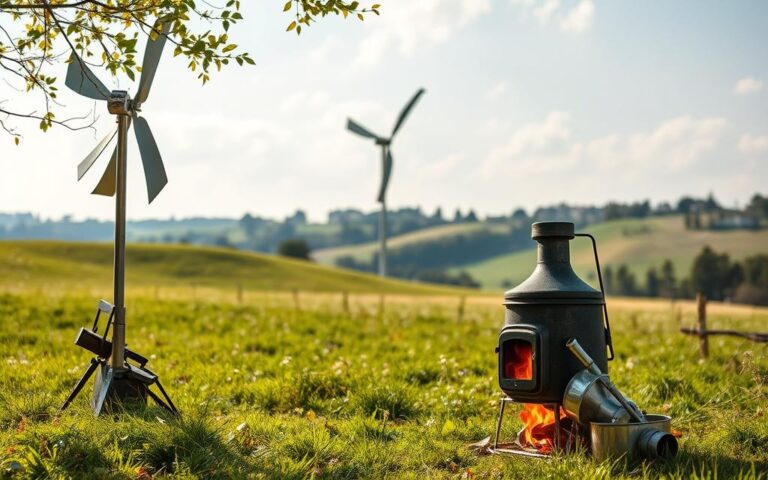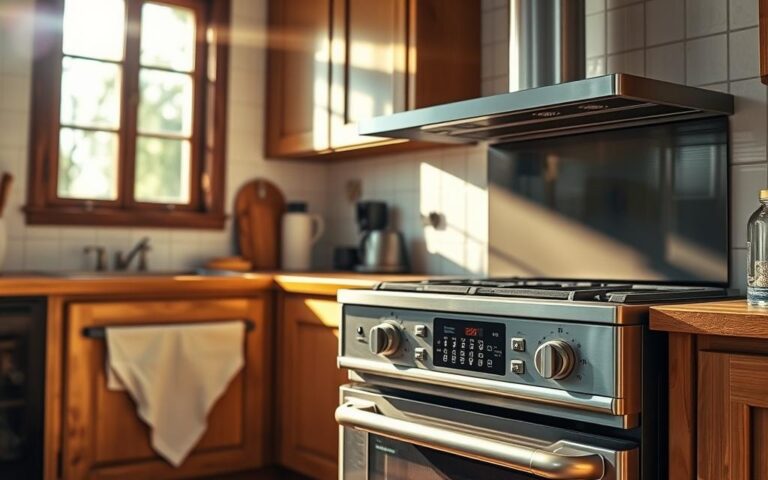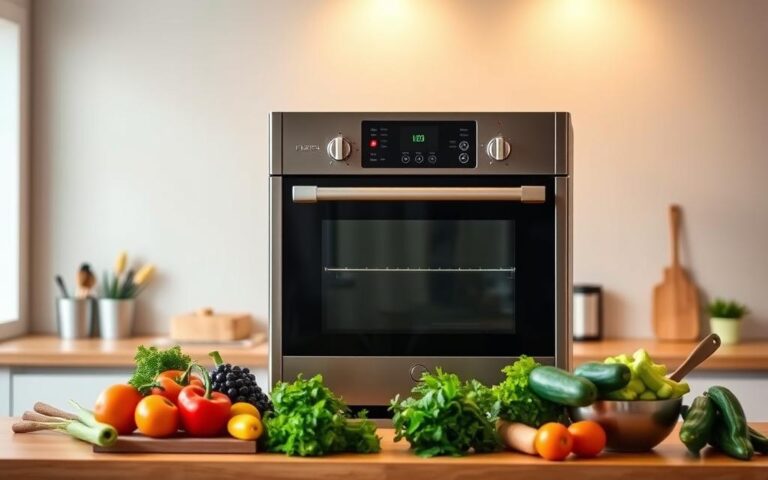One square meter of a small stream can power two household refrigerators. DIY hydroelectric power offers sustainable energy solutions for homeowners. It’s an exciting new frontier in renewable energy.
Small streams have untapped potential for clean, consistent electricity. DIY hydroelectric power provides a reliable alternative to traditional energy sources. It has minimal environmental impact, making it attractive to renewable energy fans.
This guide shows you how to create your own hydroelectric generator. You’ll learn to turn a modest water source into a personal power plant. This can cut your energy costs and reduce your carbon footprint.
New DIY techniques are making sustainable energy more accessible. If you live near a creek or small river, you can generate your own electricity. It’s easier than you might think.
We’ll simplify home-based hydroelectric generation for you. You’ll get practical, step-by-step guidance to control your energy production. Our guide empowers you to embrace this innovative technology.
Understanding Hydroelectric Power
Sustainable power generation is crucial for meeting global energy needs while protecting our environment. Micro-hydro systems offer an innovative solution for harnessing renewable energy from water resources. These systems work even on a small scale.
Hydroelectric power turns moving water’s energy into electricity through specialized mechanical systems. This clean energy approach provides many advantages for communities and property owners. It’s an excellent alternative power source.

What is Hydroelectric Power?
Hydroelectric power creates electricity by capturing water’s natural movement. The process uses water’s gravitational potential energy. It directs water through turbines and converts mechanical rotation into electrical current.
Benefits of Hydroelectric Energy
Micro-hydro systems offer environmental and economic advantages:
- Renewable and clean energy production
- Low operational maintenance costs
- Minimal carbon footprint
- Consistent power generation
Types of Hydroelectric Systems
Different hydroelectric setups suit various geographical and technical needs. The main categories include:
- Run-of-river systems: Utilize existing water flow without large reservoirs
- Storage systems: Create artificial water reserves for controlled energy generation
- Pumped-storage systems: Store energy by pumping water between elevated reservoirs
These sustainable power generation approaches offer unique benefits. Learning about them helps people explore micro-hydro systems that fit their environment. It’s an exciting way to harness clean energy.
Key Components of a DIY Hydroelectric Generator
Hydropower turbines and waterwheel generators are vital for DIY hydroelectric projects. They convert water flow into usable electrical energy. Understanding these components is crucial for building a successful hydropower system.
A hydroelectric generator has complex mechanical and electrical systems. These systems work together to produce renewable energy. Choosing the right parts can greatly affect your project’s efficiency and power output.
Turbines: The Power Converters
Hydropower turbines change water’s energy into mechanical rotation. Different turbine designs work best for various water flow conditions.
- Impulse turbines for high-head, low-volume streams
- Reaction turbines for consistent water flow
- Crossflow turbines for small-scale applications
Selecting the Right Generator
Waterwheel generators come in several types. Your project needs will determine the best choice.
- Permanent magnet generators – High efficiency for low-speed applications
- Induction generators – Robust and widely available
- Synchronous generators – Precise power production
Efficient Electrical Wiring
Good wiring is key to your hydroelectric generator’s performance. Use low-resistance copper wires and the right gauge to minimize energy loss.
Choose and combine components carefully for a successful DIY hydroelectric power project.
Choosing the Right Location for Your Project
The ideal location is key for a successful low-head hydro system in off-grid living. A good site can provide a reliable energy source. Understanding critical factors helps maximize your hydroelectric generator’s potential.
Assessing Water Flow and Availability
Water flow determines the effectiveness of your low-head hydro setup. Evaluate these key characteristics:
- Minimum water flow rate
- Seasonal water availability
- Stream gradient and drop height
- Consistent water volume
Legal Considerations for Water Use
Understanding water rights is crucial for off-grid living projects. Regions have specific rules for water use in hydroelectric generation.
| Permit Type | Required For | Typical Processing Time |
|---|---|---|
| Federal Water Rights | Streams on public lands | 3-6 months |
| State Water Permits | Local stream usage | 1-4 months |
| Environmental Impact Clearance | Ecological protection | 2-5 months |
Safety and Environmental Impact
Responsible low-head hydro setup requires careful environmental consideration. Assess impacts on local ecosystems, fish migration, and water quality before installation.
- Minimize stream bed disruption
- Protect aquatic habitat
- Maintain natural water flow
- Use fish-friendly turbine designs
Proper planning ensures your off-grid living hydroelectric project remains sustainable and environmentally conscious.
Designing Your Hydroelectric Generator
A DIY hydroelectric power system needs careful design and planning. It balances technical needs with practical limits. Homemade hydroelectricity can be a smart way to generate clean energy.
Simplified Design Concepts
Making a hydroelectric generator isn’t rocket science. It’s about water flow and energy change. The main parts are simple:
- Water intake mechanism
- Turbine configuration
- Generator connection
- Power transmission system
Evaluating Material Costs
Good budget planning is key for DIY hydroelectric projects. Smart choices can cut costs. Here are some money-saving tips:
- Repurpose existing mechanical components
- Source local materials
- Compare prices from multiple suppliers
- Calculate long-term energy savings
Prototype Testing and Adjustments
Homemade hydroelectricity needs thorough testing and tweaks. Start small to spot issues early. Measure performance metrics like energy output and water flow efficiency.
“The key to successful DIY hydroelectric power is patience and continuous refinement.”
Each version brings you closer to a better system. You’ll soon have a reliable source of clean, renewable energy.
Building the Generator: Step-by-Step Guide
DIY hydroelectric power projects need careful planning and execution. This guide will help you build a functional generator from scratch. You’ll learn the essential steps for creating your own waterwheel generators.

Essential Tools for Your Project
Gather these crucial tools before starting your DIY hydroelectric power project:
- Adjustable wrench
- Drill and drill bits
- Measuring tape
- Welding equipment
- Safety goggles
- Waterproof electrical tape
Constructing the Water Wheel
The water wheel is vital to your waterwheel generators. Choose materials that can handle constant water exposure and mechanical stress.
| Material | Durability | Cost |
|---|---|---|
| Stainless Steel | High | Expensive |
| Aluminum | Medium | Moderate |
| Treated Wood | Low | Affordable |
Assembling Electrical Components
Connecting electrical parts in your DIY system requires precision. Make sure all connections are waterproof and secure.
- Install generator near water wheel
- Connect transmission shaft
- Wire electrical connections
- Install voltage regulator
- Test system performance
Safety Tip: Always disconnect power sources before working on electrical components to prevent potential accidents.
Installing the Generator in a Stream
Run-of-river systems need careful planning and precise installation. Your DIY hydroelectric generator is a key step towards sustainable power. It turns small water streams into renewable energy sources.
Successful stream installation involves crucial steps. These ensure both performance and longevity of your hydroelectric system.
Securing the Structure
Anchoring your generator requires strategic approaches to withstand water currents:
- Select robust mounting points along stream banks
- Use stainless steel brackets for corrosion resistance
- Implement adjustable support structures
- Create flood-resistant foundation designs
Electrical Grid Connections
Connecting your power system needs technical precision:
- Install a professional-grade inverter
- Verify local electrical codes
- Request utility company inspection
- Implement safety disconnect switches
Maintenance Recommendations
Regular upkeep boosts your run-of-river system’s efficiency:
- Conduct monthly visual inspections
- Clean turbine blades quarterly
- Check electrical connections annually
- Lubricate mechanical components
Proactive maintenance ensures consistent renewable energy production and system reliability.
Troubleshooting Common Issues
DIY micro-hydro systems face unique challenges. Technical problems often arise, requiring careful diagnosis and strategic solutions. Understanding these issues helps maintain your generator’s performance and longevity.
Generator Power Production Problems
When your micro-hydro system stops generating electricity, several factors could be responsible. Common causes include reduced water flow and turbine blade misalignment.
Other issues might be mechanical wear on generator components or electrical connection interruptions.
- Reduced water flow rates
- Turbine blade misalignment
- Mechanical wear on generator components
- Electrical connection interruptions
Mechanical Failure Solutions
Mechanical issues in homemade hydroelectricity projects can often be resolved through systematic inspection. Regular visual checks of water wheel components are crucial.
Inspecting bearings and transmission mechanisms helps identify potential problems early.
Addressing Electrical Short Circuits
Electrical short circuits pose significant risks in micro-hydro systems. Proper grounding and weatherproof electrical enclosures can minimize these dangers.
Always disconnect power sources before performing any electrical diagnostics or repairs.
- Inspect wire connections regularly
- Use waterproof electrical connectors
- Install surge protection devices
- Conduct periodic resistance testing
These troubleshooting strategies help DIY enthusiasts maintain efficient micro-hydro systems. With this knowledge, you can keep your hydroelectric generator running smoothly.
Environmental Factors to Consider
Developing a DIY hydroelectric generator requires understanding environmental implications. Sustainable power generation balances innovation with ecological preservation. Careful planning can minimize negative impacts on local ecosystems.
Impact on Local Wildlife
Small-scale hydroelectric generators can disrupt aquatic habitats without thoughtful design. Protecting wildlife involves maintaining minimum water flow rates and creating fish passage mechanisms.
It’s crucial to avoid breeding and migration seasons. Using screens can prevent wildlife entrapment in the system.
- Maintaining minimum water flow rates
- Creating fish passage mechanisms
- Avoiding breeding and migration seasons
- Using screens to prevent wildlife entrapment
Erosion and Landscape Changes
Water diversion for energy can alter local landscapes. Mitigating erosion requires strategic placement and design of your generator.
Recommended strategies include conducting topographical surveys and using natural stabilization techniques. Vegetation barriers and sediment movement monitoring are also effective.
- Conducting detailed topographical surveys
- Implementing natural stabilization techniques
- Using vegetation barriers
- Monitoring sediment movement
Compliance with Local Regulations
Sustainable power generation requires strict adherence to environmental regulations. Homeowners should consult local water management authorities and obtain necessary permits.
Environmental impact assessments are crucial. Maintaining detailed documentation throughout the process is also important.
- Consult local water management authorities
- Obtain necessary permits
- Undergo environmental impact assessments
- Maintain detailed documentation
Responsible renewable energy development requires a holistic approach that respects both technological advancement and ecological balance.
Maximizing Your Hydroelectric Output
Smart planning boosts hydropower turbine performance. Off-grid living needs efficient energy generation. Every kilowatt counts for sustainable power management.
Top hydroelectric systems use various strategies. These help maximize energy production and storage. Let’s explore some key approaches.
Enhancing Water Efficiency
Water efficiency is crucial for turbine performance. These techniques can boost your system’s output:
- Conduct regular stream flow measurements
- Install precision intake screens
- Minimize water turbulence during collection
- Use smooth piping to reduce friction losses
Energy Storage Options
Off-grid living needs strong energy storage solutions. They help manage uneven water flow. Here are some storage methods to consider:
| Storage Type | Capacity | Cost Efficiency |
|---|---|---|
| Battery Banks | 5-50 kWh | Medium |
| Pumped Hydro Storage | 100-1000 kWh | High |
| Compressed Air Systems | 10-100 kWh | Low |
Monitoring Your Energy Production
Tracking turbine performance helps find ways to improve. Use digital systems for real-time data on:
- Instantaneous power generation
- Water flow rates
- Electrical output efficiency
- System health diagnostics
“Continuous monitoring transforms good hydroelectric systems into great ones.” – Renewable Energy Expert
Optimizing your system boosts off-grid energy independence. It also cuts long-term maintenance costs.
Future Trends in DIY Hydroelectric Power
DIY hydroelectric power is a rising star in sustainable energy. Low-head hydro systems are changing local energy production. Small-scale innovations help homeowners and communities use water resources with minimal environmental impact.
New technology is improving generator design. Compact turbines now make energy from smaller streams more efficiently. Modular components simplify installation and cut project costs.
These changes make renewable energy more accessible to people interested in low-head hydro solutions. They can now generate their own electricity more easily.
Community hydroelectric projects are gaining popularity in sustainable energy production. These local efforts bring neighbors together for shared renewable energy goals. Communities can pool resources and knowledge to create decentralized power networks.
DIY hydroelectric power is more than just individual projects. These grassroots efforts support larger renewable energy strategies. They show how small-scale innovations can make a big environmental difference.
As technology improves, more people will see the potential of low-head hydro systems. These systems can create clean, sustainable energy solutions for the future.
FAQ
What is a DIY hydroelectric generator?
A DIY hydroelectric generator turns flowing water into electricity using homemade parts. It uses a water wheel or turbine to capture water’s energy. These systems can power off-grid homes or provide backup electricity.
How much power can a small hydroelectric system generate?
Power output depends on water flow rate and vertical drop. Micro-hydro systems typically generate 100 watts to 10 kilowatts. This is enough to power small homes or cabins in remote areas.
What water sources are suitable for a DIY hydroelectric generator?
Streams, small rivers, and irrigation canals work well. The water source needs consistent flow and at least 2-3 feet of vertical drop. These factors help drive the turbine effectively.
What are the primary components needed for a DIY hydroelectric generator?
Key parts include a water intake system, turbine, generator, and electrical controls. You’ll also need transmission lines and battery storage. Each part helps turn water flow into usable electricity.
Are permits required for building a small hydroelectric system?
Yes, you’ll likely need water rights and environmental permits. Rules vary by location. Check with local water authorities and environmental agencies before starting your project.
How expensive is it to build a DIY hydroelectric generator?
Costs range from $1,000 to $10,000, depending on system complexity and site prep. DIY approaches can save money compared to professional installations. Many builders use recycled materials to cut costs.
What maintenance is required for a hydroelectric generator?
Regular upkeep includes cleaning intake screens and checking turbine bearings. You should also inspect electrical connections and monitor water flow. Seasonal maintenance prevents debris buildup and ensures peak performance.
Can a DIY hydroelectric system work year-round?
Performance depends on consistent water flow. Seasonal changes can affect output during dry or freezing periods. Good system design and location choice are key for year-round reliability.
What are the environmental considerations for a hydroelectric project?
Minimize disruption to water ecosystems and maintain natural flow. Prevent erosion and protect local wildlife. Small-scale systems usually have less impact than large commercial installations.
How do I determine if my property is suitable for a hydroelectric generator?
Measure water flow rate, vertical drop, and water consistency. Check site accessibility too. A professional hydrological survey can provide detailed insights into your property’s potential.



